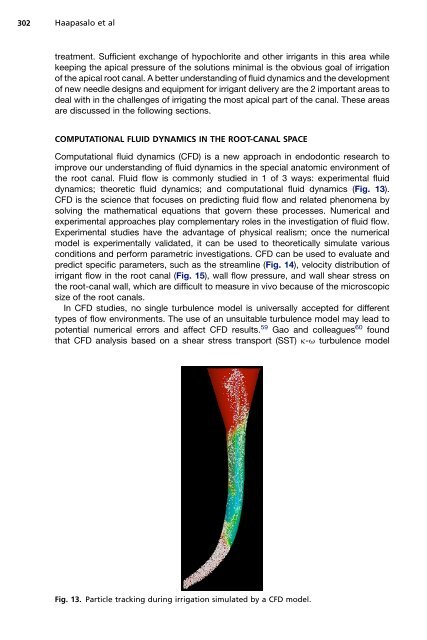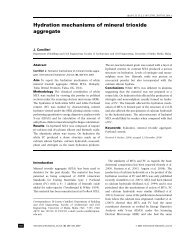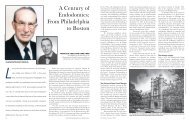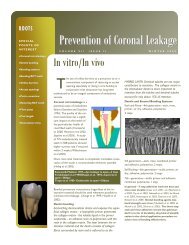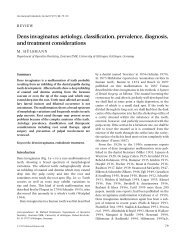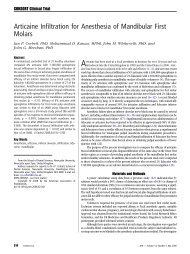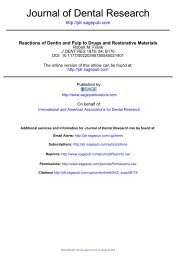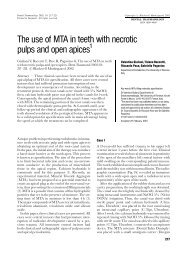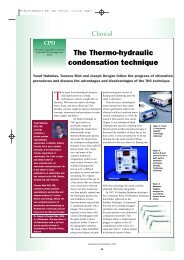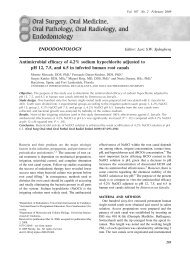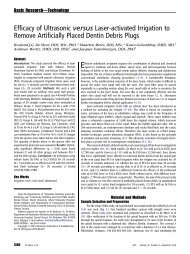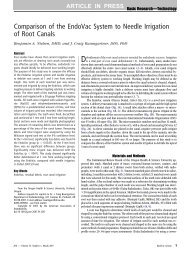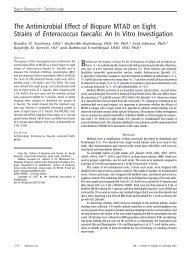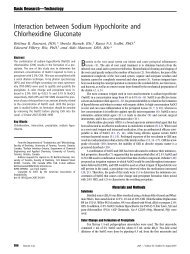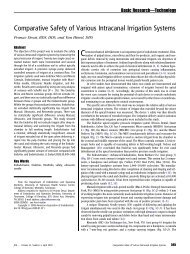Irrigation in Endodontics - The Endoexperience
Irrigation in Endodontics - The Endoexperience
Irrigation in Endodontics - The Endoexperience
Create successful ePaper yourself
Turn your PDF publications into a flip-book with our unique Google optimized e-Paper software.
302<br />
Haapasalo et al<br />
treatment. Sufficient exchange of hypochlorite and other irrigants <strong>in</strong> this area while<br />
keep<strong>in</strong>g the apical pressure of the solutions m<strong>in</strong>imal is the obvious goal of irrigation<br />
of the apical root canal. A better understand<strong>in</strong>g of fluid dynamics and the development<br />
of new needle designs and equipment for irrigant delivery are the 2 important areas to<br />
deal with <strong>in</strong> the challenges of irrigat<strong>in</strong>g the most apical part of the canal. <strong>The</strong>se areas<br />
are discussed <strong>in</strong> the follow<strong>in</strong>g sections.<br />
COMPUTATIONAL FLUID DYNAMICS IN THE ROOT-CANAL SPACE<br />
Computational fluid dynamics (CFD) is a new approach <strong>in</strong> endodontic research to<br />
improve our understand<strong>in</strong>g of fluid dynamics <strong>in</strong> the special anatomic environment of<br />
the root canal. Fluid flow is commonly studied <strong>in</strong> 1 of 3 ways: experimental fluid<br />
dynamics; theoretic fluid dynamics; and computational fluid dynamics (Fig. 13).<br />
CFD is the science that focuses on predict<strong>in</strong>g fluid flow and related phenomena by<br />
solv<strong>in</strong>g the mathematical equations that govern these processes. Numerical and<br />
experimental approaches play complementary roles <strong>in</strong> the <strong>in</strong>vestigation of fluid flow.<br />
Experimental studies have the advantage of physical realism; once the numerical<br />
model is experimentally validated, it can be used to theoretically simulate various<br />
conditions and perform parametric <strong>in</strong>vestigations. CFD can be used to evaluate and<br />
predict specific parameters, such as the streaml<strong>in</strong>e (Fig. 14), velocity distribution of<br />
irrigant flow <strong>in</strong> the root canal (Fig. 15), wall flow pressure, and wall shear stress on<br />
the root-canal wall, which are difficult to measure <strong>in</strong> vivo because of the microscopic<br />
size of the root canals.<br />
In CFD studies, no s<strong>in</strong>gle turbulence model is universally accepted for different<br />
types of flow environments. <strong>The</strong> use of an unsuitable turbulence model may lead to<br />
potential numerical errors and affect CFD results. 59 Gao and colleagues 60 found<br />
that CFD analysis based on a shear stress transport (SST) k-u turbulence model<br />
Fig. 13. Particle track<strong>in</strong>g dur<strong>in</strong>g irrigation simulated by a CFD model.


